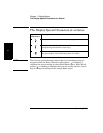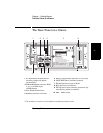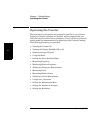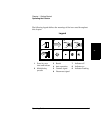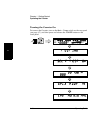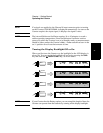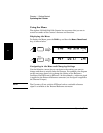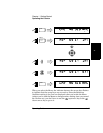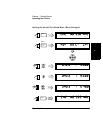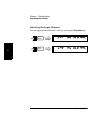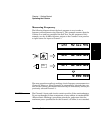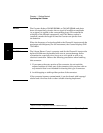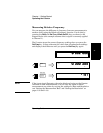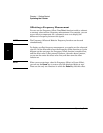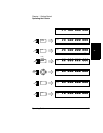
Chapter 1 Getting Started
Operating the Counter
1-14 Operating Guide
1
When you press the (right-arrow) key, the flashing annunciator ( )
changes direction, and the current setting for the Reference Oscillator
(INT [internal] or EXT [external]) flashes. This indicates that you can now
change this setting. Use either the up-arrow key or the down-arrow key to
change the setting.
If there are more than two settings available for the currently selected
function, you can cycle through the available settings by repeatedly
pressing either the up-arrow key or the down-arrow key. For example, to
change the setting for the Baud rate for the serial port, use the sequence
on the next page.
Press either the Enter key or the left arrow key to accept the currently
displayed setting. The Enter key accepts the setting and exits the Menu;
the left arrow key accepts the setting but does not exit the Menu. Use the
left arrow key to accept a setting if you want to change additional menu
settings. The Clear key reverses an unaccepted setting change.
You navigate to and adjust the remaining settings available in the Menu
in the manner described above. The Menu also contains some items that
provide information only (no settings are required [or possible] for these),
such as Battery Voltage, Operation Hours, and information that identifies
the Counter (Agilent model number, firmware version number, serial
number, and installed option codes). These menu options and the ones
described below are shown in “The Front Panel Menus at a Glance” on
page 1-4.
There is also a menu item called Preset and one called Do Self Test. If you
press the Enter key while PRESET is displayed, all of the Counter’s
settings are returned to the factory-default settings. If you press Enter
while DO SELF TEST is displayed, the Counter repeats the tests that are
normally performed when the Counter is first turned on.
NOTE Remember to terminate each value you change in any of the menu options
by pressing the
Enter key or the left arrow key. You can abort a change to
any menu option while the Menu is displayed by pressing the
Reset/Local
key or the
Clear key. Both keys nullify any changes you made to the
current menu option, but they do not affect any changes to other menu
options. The
Clear key terminates the current menu session, but the
Reset/Local key does not.



